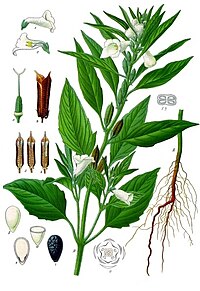
Photo from wikipedia
A strategy using bacilli was adopted aiming to investigate the mitigation of the effects of water deficit in sesame. An experiment was carried out in a greenhouse with 2 sesame… Click to show full abstract
A strategy using bacilli was adopted aiming to investigate the mitigation of the effects of water deficit in sesame. An experiment was carried out in a greenhouse with 2 sesame cultivars (BRS Seda and BRS Anahí) and 4 inoculants (pant001, ESA 13, ESA 402, and ESA 441). On the 30th day of the cycle, irrigation was suspended for eight days, and the plants were subjected to physiological analysis using an infrared gas analyzer (IRGA). On the 8th day of water suspension, leaves were collected for analysis: superoxide dismutase, catalase, ascorbate peroxidase, proline, nitrogen, chlorophyll, and carotenoids. At the end of the crop cycle, data on biomass and vegetative growth characteristics were collected. Data were submitted for variance analysis and comparison of means by the Tukey and Shapiro–Wilk tests. A positive effect of inoculants was observed for all characteristics evaluated, contributing to improvements in plant physiology, induction of biochemical responses, vegetative development, and productivity. ESA 13 established better interaction with the BRS Anahí cultivar and ESA 402 with BRS Seda, with an increase of 49% and 34%, respectively, for the mass of one thousand seeds. Thus, biological indicators are identified regarding the potential of inoculants for application in sesame cultivation.
Journal Title: Plants
Year Published: 2023
Link to full text (if available)
Share on Social Media: Sign Up to like & get
recommendations!